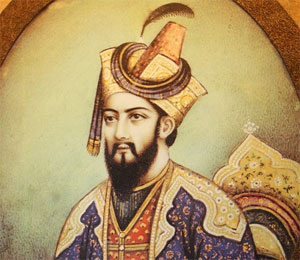Great Personalities » Aurangzeb

Aurangzeb
Aurangzeb, the sixth Mughal emperor, was considered one of the famous Mughal emperors. He expanded the Mughal Empire to its highest point, and was known as “Alamgir,” which meant World Seizer.
Aurangzeb was born on 3 November 1618 under the full name Abdul Muzaffar Muhi-ud-Din Muhammad Aurangzeb. He was the third son of Emperor Shah Jahan and Arjumand Bano Begam (also known as Mumtaz Mahal). A few amazing facts of this great emperor is given below.
He was a serious and religious boy, who was committed to the Muslim orthodox, unlike the regular traits of the royal Mughal traits who were carnal and inebriated rulers. He showed signs of military and administrative ability early.
He was very religious since childhood and was deeply interested in the Islam, and studied the Quran with great interest. He was also very courageous. It was said that once when an elephant attacked him, he fought the elephant and killed it, thus earning great respect among the people and his family members. His father rewarded him and appreciated him with the title “Bahadur” or the brave.
At the age of 18, Aurangzeb was appointed the viceroy of the Deccan by his father. It is said that his father Shah Jahan exiled from that post, due to some family strife. His relationship with his father got even bitterer, when his father appointed Dara Shikoh, the elder brother of Aurangzeb as the emperor. Some years later Shah Jahan re-appointed Aurangzeb as the Viceroy of Deccan.
In 1653, he returned to the Deccan to restore law and order and to re-establish the Mughal revenue system that had initially been introduced by Emperor Akbar. During this period, his relations with Emperor Shah Jahan's principal adviser, and who happened to be his eldest brother, Dara Shukoh, deteriorated.
While, Aurangzeb believed in Muslim orthodoxy and violent territorial expansion, Dara stood for a secular empire with imperial consolidation. Thus, a clash for succession to the throne was inevitable.
When Shah Jahan fell ill in September 1657, Aurangzeb challenged the brilliant albeit volatile Dara Shikoh, who was designated by their father as his successor to the throne. Aurangzeb defeated and killed him. He then imprisoned his father and assumed imperial authority on 21 July 1658. His next step was to execute his remaining three brothers and their two sons. After that, he crowned himself Emperor of India, assuming the title Alamgir (Conqueror of the World) on 5 June 1659.
He then started building a strong army and started expanding his empire. He conquered Punjab, Bijapur and many other states. However, Aurangzeb was not as tolerant as his father or grandfather. He could not tolerate other religions and in the process destroyed many of the Hindu temples. He also banned dancing, singing, and playing musical instruments in his empire. He was not open-minded and spend most of his time fighting against rebellions.
Aurangzeb was committed to making India an orthodox Muslim state. As a result, Aurangzeb destroyed many Hindu temples and banned Hindu festivals. Censors or Royal religious police were appointed to enforce morals, and edicts were issued against gambling, drinking, prostitution, and narcotics. Furthermore, a poll tax on Hindus was imposed in 1679. Tegh Bahadur, a defiant Sikh guru who had refused to embrace Islam was executed. Non-Muslims were not given employment in the imperial bureaucracy.
Aurangzeb applied his great-grandfather Akbar’s principles when he conquered a state. He initially defeated his enemies, reconciled with them, and then place them in the imperial service. However, when Shivaji was defeated, he was called to Agra for reconciliation in 1666, and given an imperial rank. The plan broke down, and Shivaji escaped. He later died sometime during 1680 as a monarch of an independent Maratha sovereign state. It was during this time that Shivaji re-established the Maratha Empire. The people of Bharatpur stood against him and created Bharatpur state. The Sikhs rebelled against the emperor and fought many battles.
Such discriminatory policies naturally led to rebellions. In 1660, the Marathas began a revolt. This revolt was followed by the Jats rebellion in 1669. Soon the Satnamis followed suit in 1672 and the Sikhs in 1675. Finally, the Rajputs also began their revolt in 1679. To make matters worse, in 1686, the English East India Company also decided to take up arms against him. Although, one by one all these revolts were subdued, their victories were often short-lived. Mughal imperial unity was lost, and the treasury was completely exhausted.
While Hindus continued to serve the empire, there was no enthusiasm any more. The Deccan kingdoms of Bijapur and Golconda were conquered in 1686–87. However, the insecurity that followed triggered a long-evolving economic crisis. This was further worsened by the war against the Marathas. Although Shivaji’s son Sambhaji was executed sometime in 1689 and the Maratha kingdom breaking up, the Marathas, then started adopting guerrilla tactics. This soon spread to all over southern India, which soon gained sympathy. Aurangzeb and his armies were kept busy in fruitless blockades of forts in the Maratha hill country, which was further drain on their treasury.
It was said that the annual yearly tribute to the empire in 1690 was over fifty million dollars. He also expanded his region up to 32 million square kilometers.
Aurangzeb maintained the empire for nearly half a century and in fact extended it in the south as far as Tanjore. However, behind all this were serious weaknesses. The Maratha campaign continually drained the imperial resources. The militancy of the Sikhs and the Jats boded ill for the empire in the north. The new Islamic policy estranged Hindu sentiment and damaged Rajput support. The financial pressure on the land strained the entire administrative framework.
Under Aurangzeb's piety and austerity, Mughal culture also suffered. Music and arts lost royal patronage, and the position of women rapidly declined. The Emperor strove to live up to the ideals of orthodox Islam. In his free time, Aurangzeb translated the Koran so that he could provide for his cremation expenses. He was a man of literary tastes, and his letters were a model of elegant Persian prose.
Finally, at the ripe old age of 90, with all his faculties intact, except hearing, he died on 20 Feb, 1707.
Aurangzeb was the last of the famous Mughal emperors. When he died after a reign of nearly 49 years on 20 February 1707 and was buried in Daulatabad. He left an empire not yet moribund but confronted with a number of menacing problems. The failure of his son’s successors to cope with them led to the collapse of the empire in the mid-18th century. After his death, the Mughal Empire deteriorated.
Was this article useful? What should we do to improve your experience? Share your valued feedback and suggestions!
Help us to serve you better. Donate Now!

